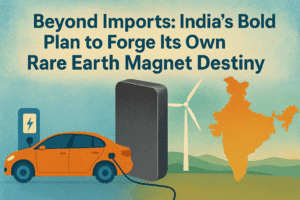Beyond Imports: India’s Bold Plan to Forge Its Own Rare Earth Magnet Destiny
India launches an urgent mission to break China’s rare earth magnet chokehold. With over 90% of these vital components for EVs and renewables imported from China, recent disruptions exposed critical vulnerabilities. Despite holding the world’s 5th largest rare earth reserves, India produces less than 1% of global magnets.
A new blueprint outlines a decisive five-pillar strategy: guaranteeing market demand for investors, establishing integrated production clusters in mineral-rich states, launching a national R&D hub for innovation and recycling, creating a high-powered coordination cell to slash bureaucracy, and embedding sustainability from the start. Backed by a ₹34,300 crore Critical Minerals Mission, the plan aims to compress decades of development into a crucial 3-5 year window. Success hinges on unprecedented government-industry alignment to transform India from resource-rich yet capacity-poor into a self-reliant magnet power. The race is on to secure the foundation of its green industrial future.

Beyond Imports: India’s Bold Plan to Forge Its Own Rare Earth Magnet Destiny
The silent hum of an electric vehicle (EV) and the spin of a wind turbine rely on an invisible powerhouse: rare earth magnets. For India, this critical technology has been a vulnerability, with over 90% of its supply chain tethered to China. A new, ambitious blueprint by Primus Partners, “From Extraction to Innovation,” charts a five-pillar path to shatter this dependence and position India as a self-reliant force in the global magnet arena.
Why Rare Earth Magnets Matter (and Why China’s Dominance Hurts):
- The Heart of Green Tech: Neodymium and other rare earth magnets are indispensable for EV motors, wind turbine generators, and advanced defence systems. No magnets, no green transition.
- The China Factor: Controlling 92% of global magnet production, China’s recent export restrictions and customs delays have caused painful disruptions for Indian manufacturers, including major auto component suppliers. This isn’t just an economic issue; it’s a strategic chokepoint.
- India’s Paradox: Despite possessing the world’s 5th largest rare earth reserves, India contributes less than 1% to global magnet output. As Davinder Sandhu, Co-Founder of Primus Partners, starkly puts it: “We can’t afford to remain resource-rich and capacity-poor.”
Primus Partners’ Five-Pillar Blueprint for Self-Reliance:
Market Assurance: De-risking the Investment Leap:
- The Challenge: Building domestic capacity requires massive investment, deterred by volatile global neodymium prices and uncertain demand.
- The Solution: Government-backed price guarantees and long-term offtake agreements with key sectors (Automotive, Defence, Renewables). This provides the market certainty private players need to commit capital.
Integrated Clusters: Building the Production Engine:
- The Challenge: Fragmented efforts won’t scale. India needs concentrated hubs linking mineral extraction to finished magnets.
- The Solution: Establish integrated pilot-scale clusters in mineral-rich states like Odisha, Andhra Pradesh, and Tamil Nadu. Crucially, identify and nurture three “industrial champions” to drive rapid scaling and technological leadership.
National Innovation Hub: Fueling the Future:
- The Challenge: Simply replicating existing tech isn’t enough; India needs breakthroughs in efficiency and sustainability.
- The Solution: Launch a dedicated National Rare Earth Innovation Hub. Focus areas include magnet recycling (potentially supplying 40,000 tonnes globally by 2030), improving magnet efficiency, and developing cleaner, cheaper processing technologies. R&D is the key to long-term competitiveness.
Ecosystem Coordination: Cutting the Red Tape:
- The Challenge: Multiple ministries (Mines, Heavy Industry, Defence, Science & Tech, Environment) and complex clearances can stall progress. Time is critical.
- The Solution: Create a high-powered Magnet Ecosystem Coordination Cell. Its mandate: align government efforts, fast-track approvals, and relentlessly track progress within a tight 3-5 year strategic window. Bureaucracy cannot be the bottleneck.
Recycling & Sustainability: Closing the Loop:
- The Challenge: Virgin mineral extraction is environmentally intensive. Future supply chains must be circular.
- The Solution: Embed recycling as a core pillar from the outset. The Innovation Hub will drive R&D in recovering rare earths from end-of-life products (like old EVs and hard drives), reducing reliance on primary mining and bolstering environmental credentials.
The Stakes and the Path Forward:
The government’s allocation of ₹1,345 crore to incentivize magnet production and the broader ₹34,300 crore Critical Minerals Mission are foundational steps. However, as Nikhil Dhaka, Vice President at Primus Partners, warns: “Without urgent localisation, technology innovation, faster approvals, and strong private-sector partnerships, every [EV] vehicle we build will carry the same import dependence we face today.”
The report underscores a critical reality: China built its dominance over decades. India doesn’t have that luxury. Success demands unprecedented coordination between government and industry, aggressive investment in R&D and infrastructure, and a relentless focus on execution. The prize? Not just securing the supply chains for India’s EV and renewable energy ambitions, but also positioning the nation as a significant player in a high-value, strategically vital global market. The blueprint is clear; the time for decisive action is now. India’s journey from resource holder to magnet powerhouse begins.
You must be logged in to post a comment.